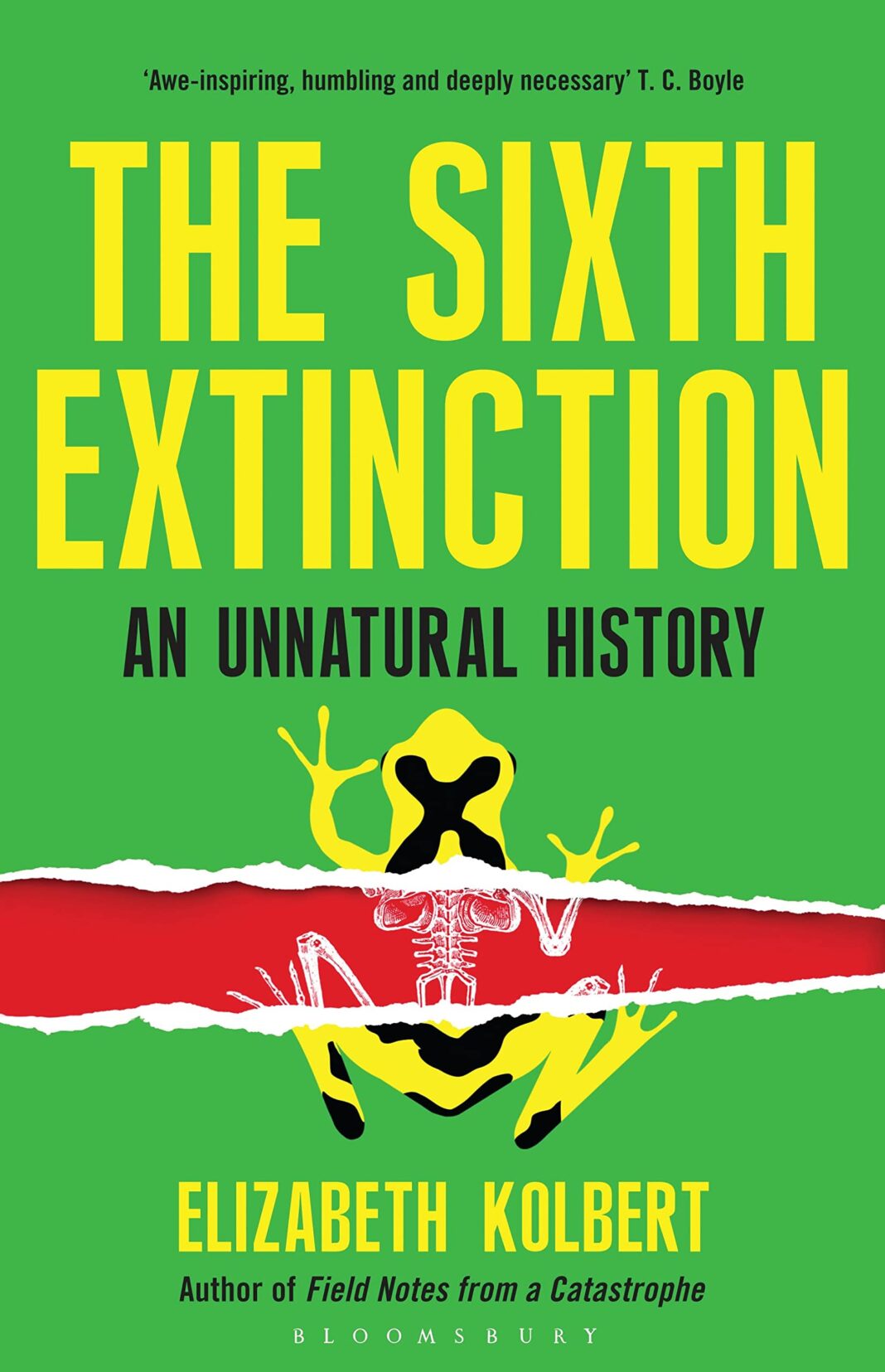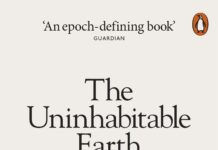If there is danger in the human trajectory, it is not so much in the survival of our own species as in the fulfillment of the ultimate irony of organic evolution: that in the instant of achieving self-understanding through the mind of man, life has doomed its most beautiful creations. —E. O. WILSON
==========
This means that, since there are about fifty-five hundred mammal species wandering around today, at the background extinction rate you’d expect—once again, very roughly—one species to disappear every seven hundred years.
==========
Today, amphibians enjoy the dubious distinction of being the world’s most endangered class of animals; it’s been calculated that the group’s extinction rate could be as much as forty-five thousand times higher than the background rate. But extinction rates among many other groups are approaching amphibian levels. It is estimated that one-third of all reef-building corals, a third of all freshwater mollusks, a third of sharks and rays, a quarter of all mammals, a fifth of all reptiles, and a sixth of all birds are headed toward oblivion.
==========
This idea received a boost in 1984, when a pair of paleontologists from the University of Chicago published a comprehensive analysis of the marine fossil record. The study revealed that in addition to the five major mass extinctions, there had been many lesser extinction events. When all of these were considered together, a pattern emerged: mass extinctions seemed to take place at regular intervals of roughly twenty-six million years. Extinction, in other words, occurred in periodic bursts, like cicadas crawling out of the earth. The two paleontologists, David Raup and Jack Sepkoski, were unsure what had caused these bursts, but their best guess was some “astronomical and astrophysical cycle,” having to do with “the passage of our solar system through the spiral arms of the Milky Way.”
==========
More significantly, upon further analysis, the evidence for periodicity began to fall apart. “If there’s a consensus, it’s that what we were seeing was a statistical fluke,” David Raup told me.
==========
One theory has it that the glaciation was produced by the early mosses that colonized the land and, in so doing, helped draw carbon dioxide out of the air. If this is the case, the first mass extinction of animals was caused by plants.
==========
The end-Permian extinction also seems to have been triggered by a change in the climate. But in this case, the change went in the opposite direction. Right at the time of extinction, 252 million years ago, there was a massive release of carbon into the air—so massive that geologists have a hard time even imagining where all the carbon could have come from. Temperatures soared—the seas warmed by as much as eighteen degrees—and the chemistry of the oceans went haywire, as if in an out-of-control aquarium. The water became acidified, and the amount of dissolved oxygen dropped so low that many organisms probably, in effect, suffocated. Reefs collapsed. The end-Permian extinction took place, though not quite in a human lifetime, in geologic terms nearly as abruptly; according to the latest research by Chinese and American scientists, the whole episode lasted no more than two hundred thousand years, and perhaps less than a hundred thousand. By the time it was over, something like ninety percent of all species on earth had been eliminated
==========
If an asteroid had produced one “chasm” in the fossil record, it seemed reasonable to expect that impacts had caused all of them. This idea received a boost in 1984, when a pair of paleontologists from the University of Chicago published a comprehensive analysis of the marine fossil record. The study revealed that in addition to the five major mass extinctions, there had been many lesser extinction events. When all of these were considered together, a pattern emerged: mass extinctions seemed to take place at regular intervals of roughly twenty-six million years. Extinction, in other words, occurred in periodic bursts, like cicadas crawling out of the earth. The two paleontologists, David Raup and Jack Sepkoski, were unsure what had caused these bursts, but their best guess was some “astronomical and astrophysical cycle,” having to do with “the passage of our solar system through the spiral arms of the Milky Way.” A group of astrophysicists—as it happened, colleagues of the Alvarezes at Berkeley—took the speculation one step farther. The periodicity, the group argued, could be explained by a small “companion star” to the sun, which, every twenty-six million years, passed through the Oort cloud, producing comet showers that rained destruction on the earth.
==========
The current theory is that the end-Ordovician extinction was caused by glaciation. For most of the period, a so-called greenhouse climate prevailed—carbon dioxide levels in the air were high and so, too, were sea levels and temperatures. But right around the time of the first pulse of extinction—the one that wreaked havoc among the graptolites—CO2 levels dropped. Temperatures fell and Gondwana froze.
==========
Ocean acidification is sometimes referred to as global warming’s “equally evil twin.”
==========
No single mechanism explains all the mass extinctions in the record, and yet changes in ocean chemistry seem to be a pretty good predictor. Ocean acidification played a role in at least two of the Big Five extinctions (the end-Permian and the end-Triassic) and quite possibly it was a major factor in a third (the end-Cretaceous). There’s strong evidence for ocean acidification during an extinction event known as the Toarcian Turnover, which occurred 183 million years ago, in the early Jurassic, and similar evidence at the end of the Paleocene, 55 million years ago, when several forms of marine life suffered a major crisis.
==========
Other calculations of his show that to keep pace with the present rate of temperature change, plants and animals would have to migrate poleward by thirty feet a day, and that a molecule of CO2 generated by burning fossil fuels will, in the course of its lifetime in the atmosphere, trap a hundred thousand times more heat than was released in producing it.
==========
A second theory posits that the tropics hold more species because tropical species are finicky. According to this line of reasoning, what’s important about the tropics is that temperatures there are relatively stable. Thus tropical organisms tend to possess relatively narrow thermal tolerances, and even slight climatic differences, caused, say, by hills or valleys, can constitute insuperable barriers. (A famous paper on this subject is titled “Why Mountain Passes Are Higher in the Tropics.”) Populations are thus more easily isolated, and speciation ensues.
==========
Wood storks cool off by defecating on their own legs. (In very hot weather, wood storks may excrete on their legs as often as once a minute.)
==========
For the last forty million years or so, the earth has been in a general cooling phase. It’s not entirely clear why this is so, but one theory has it that the uplift of the Himalayas exposed vast expanses of rock to chemical weathering, and this in turn led to a drawdown of carbon dioxide from the atmosphere. At the start of this long cooling phase, in the late Eocene, the world was so warm there was almost no ice on the planet. By around thirty-five million years ago, global temperatures had declined enough that glaciers began to form on Antarctica. By three million years ago, temperatures had dropped to the point that the Arctic, too, froze over, and a permanent ice cap formed. Then, about two and a half million years ago, at the start of the Pleistocene epoch, the world entered a period of recurring glaciations. Huge ice sheets advanced across the Northern Hemisphere, only to melt away again some hundred thousand years later.
==========
It is now generally believed that ice ages are initiated by small changes in the earth’s orbit, caused by, among other things, the gravitational tug of Jupiter and Saturn. These changes alter the distribution of sunlight across different latitudes at different times of year. When the amount of light hitting the far northern latitudes in summer approaches a minimum, snow begins to build up there. This initiates a feedback cycle that causes atmospheric carbon dioxide levels to drop. Temperatures fall, which leads more ice to build up, and so on. After a while, the orbital cycle enters a new phase, and the feedback loop begins to run in reverse. The ice starts to melt, global CO2 levels rise, and the ice melts back farther.
==========
There’s no reason to suppose, in the abstract, that a warmer world would be any less diverse than a colder one; on the contrary, several possible explanations for the “latitudinal diversity gradient” suggest that, over the long term, a warmer world would be more varied. In the short term, though, which is to say, on any timescale that’s relevant to humans, things look very different.
==========
One of the defining features of the Anthropocene is that the world is changing in ways that compel species to move, and another is that it’s changing in ways that create barriers—roads, clear-cuts, cities—that prevent them from doing so.
==========
In the eighteen hundreds, the American chestnut was the dominant deciduous tree in eastern forests; in places like Connecticut, it made up close to half the standing timber. (The tree, which can resprout from the roots, did fine even when heavily logged; “not only was baby’s crib likely made of chestnut,” a plant pathologist named George Hepting once wrote, “but chances were, so was the old man’s coffin.”) Then, around the turn of the century, Cryphonectria parasitica, the fungus responsible for chestnut blight, was imported to the U.S., probably from Japan. Asian chestnut trees, having coevolved with Cryphonectria parasitica, were easily able to withstand the fungus, but for the American species it proved almost a hundred percent lethal. By the nineteen-fifties, it had killed off practically every chestnut in the U.S.—some four billion trees.
==========
The very year On the Origin of Species was published, a member of an acclimatization society based in Melbourne released the first rabbits into Australia. They’ve been breeding there like, well, rabbits ever since. In 1890, a New York group that took as its mission “the introduction and acclimatization of such foreign varieties of the animal and vegetable kingdom as might prove useful or interesting” imported European starlings to the U.S. (The head of the group supposedly wanted to bring to America all the birds mentioned in Shakespeare.) A hundred starlings let loose in Central Park have by now multiplied to more than two hundred million.
==========
The immediate effect of all this reshuffling is a rise in what might be called local diversity. Pick any place on earth—Australia, the Antarctic Peninsula, your local park—and, more likely than not, over the last few hundred years the number of species that can be found in the area has grown.
==========
For the same reasons that local diversity has, as a general rule, been increasing, global diversity—the total number of different species that can be found worldwide—has dropped.
==========
The megafauna extinction, it’s now clear, did not take place all at once, as Lyell and Wallace believed it had. Rather, it occurred in pulses. The first pulse, about forty thousand years ago, took out Australia’s giants. A second pulse hit North America and South America some twenty-five thousand years later. Madagascar’s giant lemurs, pygmy hippos, and elephant birds survived all the way into the Middle Ages. New Zealand’s moas made it as far as the Renaissance. It’s hard to see how such a sequence could be squared with a single climate change event. The sequence of the pulses and the sequence of human settlement, meanwhile, line up almost exactly.
==========
When the Maori reached New Zealand, around the time of Dante, they found nine species of moa living on the North and South Islands. By the time European settlers arrived, in the early eighteen hundreds, not a single moa was to be seen. What remained were huge middens of moa bones, as well as the ruins of large outdoor ovens—leftovers of great, big bird barbecues. A recent study concluded that the moas were probably eliminated in a matter of decades. A phrase survives in Maori referring, obliquely, to the slaughter: Kua ngaro i te ngaro o te moa. Or “lost as the moa is lost.”
==========
Before humans emerged on the scene, being large and slow to reproduce was a highly successful strategy, and outsized creatures dominated the planet. Then, in what amounts to a geologic instant, this strategy became a loser’s game. And so it remains today, which is why elephants and bears and big cats are in so much trouble and why Suci is one of the world’s last remaining Sumatran rhinos. Meanwhile, eliminating the megafauna didn’t just eliminate the megafauna; in Australia at least it set off an ecological cascade that transformed the landscape. Though it might be nice to imagine there once was a time when man lived in harmony with nature, it’s not clear that he ever really did.
==========
Somewhere in our DNA must lie the key mutation (or, more probably, mutations) that set us apart—the mutations that make us the sort of creature that could wipe out its nearest relative, then dig up its bones and reassemble its genome.
==========
The effort to save the whooping crane has involved even more man-hours, most provided by volunteers. Each year, a team of pilots flying ultralight aircraft teaches a new cohort of captive-raised crane chicks how to migrate south for the winter, from Wisconsin to Florida. The journey of nearly thirteen hundred miles can take up to three months, with dozens of stops on private land that owners give over to the birds. Millions of Americans who don’t participate directly in such efforts support them indirectly, by joining groups like the World Wildlife Fund, the National Wildlife Federation, Defenders of Wildlife, the Wildlife Conservation Society, the African Wildlife Foundation, the Nature Conservancy, and Conservation International.
==========
What matters is that people change the world. This capacity predates modernity, though, of course, modernity is its fullest expression. Indeed, this capacity is probably indistinguishable from the qualities that made us human to begin with: our restlessness, our creativity, our ability to cooperate to solve problems and complete complicated tasks. As soon as humans started using signs and symbols to represent the natural world, they pushed beyond the limits of that world.
==========
Among the many lessons that emerge from the geologic record, perhaps the most sobering is that in life, as in mutual funds, past performance is no guarantee of future results. When a mass extinction occurs, it takes out the weak and also lays low the strong. V-shaped graptolites were everywhere, and then they were nowhere. Ammonites swam around for hundreds of millions of years, and then they were gone. The anthropologist Richard Leakey has warned that “Homo sapiens might not only be the agent of the sixth extinction, but also risks being one of its victims.” A sign in the Hall of Biodiversity offers a quote from the Stanford ecologist Paul Ehrlich: IN PUSHING OTHER SPECIES TO EXTINCTION, HUMANITY IS BUSY SAWING OFF THE LIMB ON WHICH IT PERCHES.




